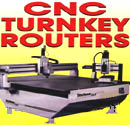SIMPLICITY OF CAD/CAM SOFTWARE, CNC
ROUTER IS A PROFITABLE SURPRISEBy Dave Salverson
Production Manager
Display Connection
West Chicago, Illinois
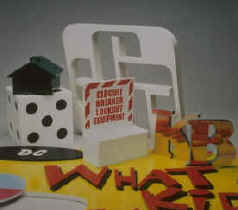 Switching from a pin
router to a CNC router has cut the time required to produce point of purchase displays by
up to 80% while substantially improving their appearance. The major drawbacks of
the pin router are the lengthy period of time required to build the pattern and the
difficulty of following the pattern when cutting the display which leads to inaccuracies.
The CNC router makes it possible to define the geometry of the display on the computer in
a fraction of the time required to build a pattern. Once the geometry is defined, it can
be produced with perfect accuracy without relying on the operator. The use of CAD/CAM
software and the CNC router originally appeared daunting to a small shop with no
automation experience, but the simplicity and ease of use of this technology was a
pleasant surprise. It is now possible for Display Connection to easily beat the prices,
quality and delivery time of competitors who still mainly produce displays by hand. Switching from a pin
router to a CNC router has cut the time required to produce point of purchase displays by
up to 80% while substantially improving their appearance. The major drawbacks of
the pin router are the lengthy period of time required to build the pattern and the
difficulty of following the pattern when cutting the display which leads to inaccuracies.
The CNC router makes it possible to define the geometry of the display on the computer in
a fraction of the time required to build a pattern. Once the geometry is defined, it can
be produced with perfect accuracy without relying on the operator. The use of CAD/CAM
software and the CNC router originally appeared daunting to a small shop with no
automation experience, but the simplicity and ease of use of this technology was a
pleasant surprise. It is now possible for Display Connection to easily beat the prices,
quality and delivery time of competitors who still mainly produce displays by hand.
Display Connection produces wood, plastic and laminate point
of purchase displays, prototypes and models. In the past, the company produced these
products with a pin router. Layouts for these parts were produced in actual size on a
piece of paper on the pattern material itself. Either a bandsaw or jigsaw was then used to
cut the pattern along the layout line. The pattern was then fastened to the actual
material so that it could serve as a guide for the router.
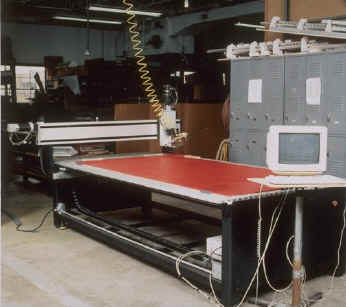
One of the Techno routers
used by Display Connection.
One problem with this approach was the amount of time
required to produce the pattern. Another was that any inaccuracy in the pattern or in the
way that the operator followed the pattern was immediately transmitted to the finished
part. The pencil line itself produced a built-in error that limited the level of precision
that could be achieved. If the customer wanted to make a change in the part, it usually
meant that the pattern had to be rebuilt from scratch. The pin router was also poorly
suited to certain types of displays such as a design with a large number of cut-out
shapes. Each shape required that a hole be drilled and the router bit dropped into the
hole to finish out the shape, a difficult job for all but the most experienced workers.
Display Connection executives realized that CAD/CAM
technology could alleviate some of these problems, but when they looked at
computer-controlled woodworking machines, they saw prices in the neighborhood of $60,000.
That was impossible to justify at the company's current workload. Then the company heard
about the Series III PC-driven CNC wood router (Techno-Isel, New Hyde Park, New York)
which costs less than $16,000 and is designed for production routing and drilling on a
wide variety of materials including wood, plastic, MDF, solid surfacing materials and
nonferrous metals.
Working area for the router is 56 inches by 96 inches and
Z-axis height options range from 4.0 inches to 19 inches. Table technical specifications
include a rapid travel rate of 200 inches per minute, a Z-axis cutting force of 200 lbs.
maximum, 0.0005 inch resolution and repeatability and 0.003 inches/ft. absolute accuracy.
The system includes the Mastercam CNC programming system (CNC Software Inc., Tolland,
Connecticut) which, although originally designed for metalworking, is ideally suited for
point of purchase displays because of its ability to generate the most complex contours
with little programming effort. The program features true 3-D geometry construction plus
IGES, DXF and CADL converters so that geometry can be uploaded from nearly any CAD system.
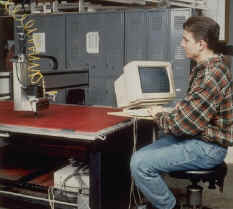
The CNC router makes it possible to define
the geometry of the display on the computer in a
fraction of the time required to build a pattern.
Now, the company uses the CNC programming software to define
the geometry for the display. This takes far less time than is required to produce an
equivalent pattern. Better yet, the computer program draws perfect lines and circles and
allows geometry to be copied, moved, rotated and so on with perfect accuracy. Once the
geometry is defined, it can be precisely cut with the operator only needed at the
beginning to load the machine. If the customer makes changes, they can be easily
incorporated into the program. The changes can usually be made in minutes on the screen
and a new display cut directly without having to spend hours creating a new pattern.
A 25 inch wide by 18 high display has 4 rows of 10 triangular
holes that are later filled with golf clubs. Producing this type of display with a pin
router was difficult because it took a long time to set up a drilling jig and the operator
had to follow the pattern very carefully to avoid jumping the pin. It took about 2 hours
to build the pattern and 15 minutes to drill and route each hole. With the pin router, it
takes only 10 minutes to produce the pattern using CNC programming software. One of the
reasons this goes so fast is that the operator only has to draw one triangle, copy it nine
times to create one row, then copy the row three times. Each hole can then be produced in
5 minutes by a relatively inexperienced operator.
Another typical display produced by the company requires a
large script letter. The problem in producing this letter with a pin router is that it has
several thin spots where, if the operator isn't very careful, the pattern will start to
vibrate and produce a rough cut or even knock the pin off track and destroy the material.
It took several hours to produce the pattern and 15 minutes to drill and route each hole
with the pin router. It takes only 10 minutes to produce the pattern using the CNC router
and CAD/CAM software.
Display Connection recently produced 18,000 plastic meal
holder displays for a fast food company with the CNC router. The company never would have
received the job without the new machine because cost and delivery time would have been
too great. The CNC router made it possible to program the geometry in about one hour and
then cut each piece in about 2 minutes with a bull nose end mill. A bull nose end mill is
like a conventional square end mill except that it has radiused corners.
The Techno machine has a positioning
accuracy of +.1 mm (+0.004) in 300 mm and a repeatability of +0.01 mm. Since this is far
greater than hand cutting, manual finishing operations are minimal. This also cuts down on
the time Display Connection must allot for its projects. The accuracy of the router
is the result of several features inherent to the table, such as the use of ball screws
and servo motors. For example, anti-backlash ball screws in Techno routers permit
play-free motion that makes it possible to produce circles accurate to the 0.0005 inch
machine resolution. These ballscrews also make it possible to produce wooden parts as
accurate as the machine resolution. The ballscrews have excellent power transmission due
to the rolling ball contact between the nut and screw. This rolling contact also ensures
longer life and greater rigidity during the life of the system because of the reduced wear
as compared to ACME screws and nuts, which have a sliding friction contact.
In two years of operation, the company has never had any
problems with the machine. This is partly due to the strength and rigidity of the table.
The Techno machine is constructed from extruded aluminum profiles that can support all the
materials that Display Connection uses and provides easy clamping capability. The machine
also has four ground and hardened steel shafts and eight recirculating bearings in each
axis. This shaft and bearing system produces very smooth play-free motion and an extremely
rigid system that produces high quality cuts.
When Display Connection recently purchased a second and third
Techno CNC router, it opted to have them equipped with a servo motor rather than stepper
motor because it provides smoother curved cuts. A servo motor is better than a stepper
motor in providing continuous motion because it works on the principle of constant
feedback. The program tells the router to follow a specific path by giving it a series of
voltages. It drives to the locations by getting constant feedback along the way. Stepper
motors are less expensive than servo motors and are fine for straight line motions and
simple circular arcs. But, in general, servos are up to three times faster and more
reliable when performing arbitrary curves like splines or 3D carvings.
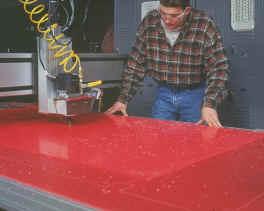
Display Connection has improved productivity
by 200% to 1000% in its production of wood,
plastic, and laminate displays.
All in all, Display Connection has
improved productivity by 200% to 1000% in producing a wide range of point of purchase
displays and prototypes. Quality of the company's products has increased by a similar
factor. Productivity gains of this magnitude have made it possible for the company
to increase profit margins even while lowering its prices to its customers by as much as
50%. The relatively small investment in the CNC router and CAD/CAM software have provided
a dramatic return on investment. The result is a dramatic improvement in the company's
competitive position -- it can do the job better, faster and for less money.
For more information, contact Techno-Isel, 2101 Jericho
Turnpike, New Hyde Park, NY 11040. Ph: 516-328-3970, Fax: 516-326-8827.
--------------------------------
PHOTOS: Andrew Young Photography |

